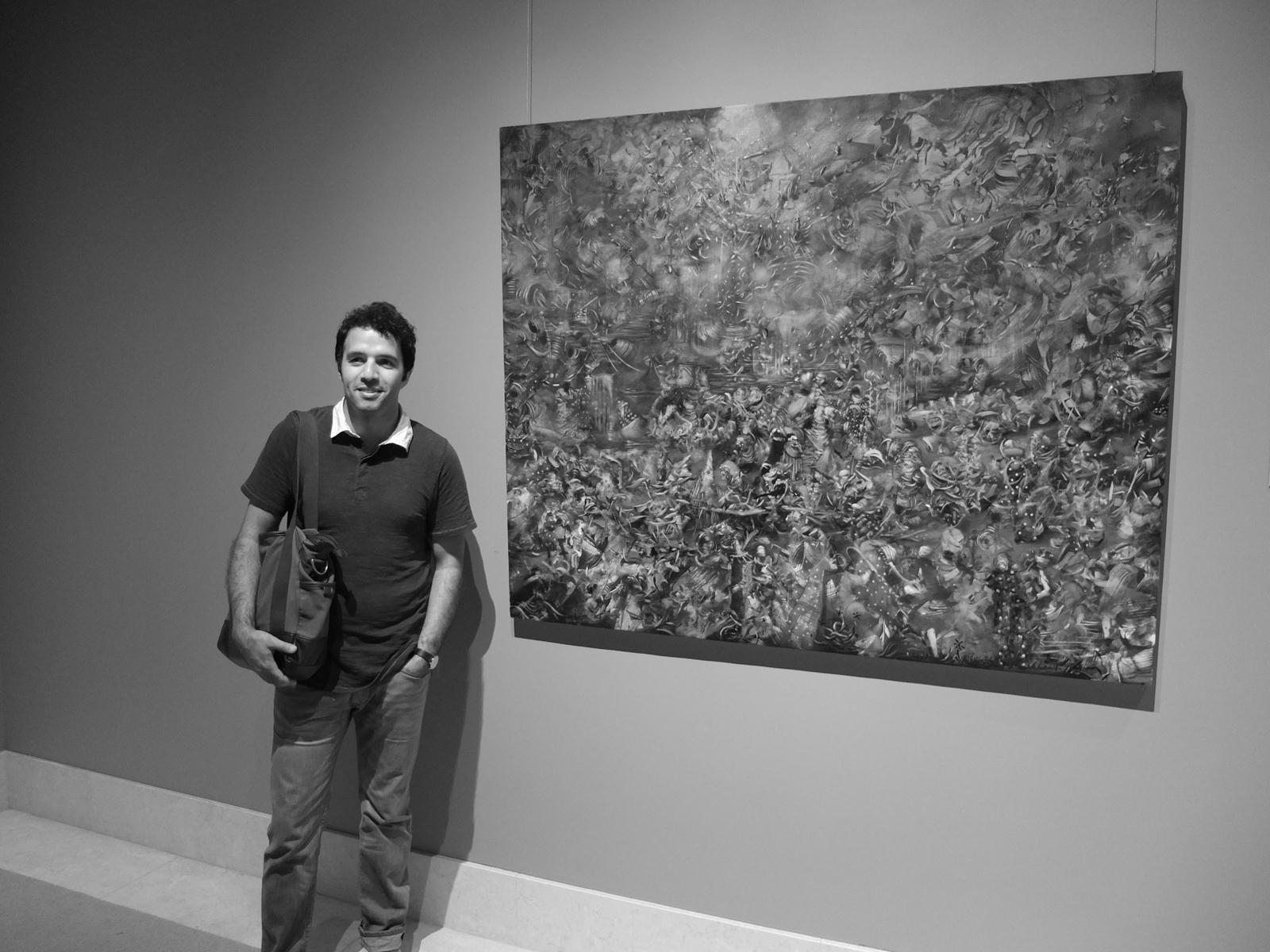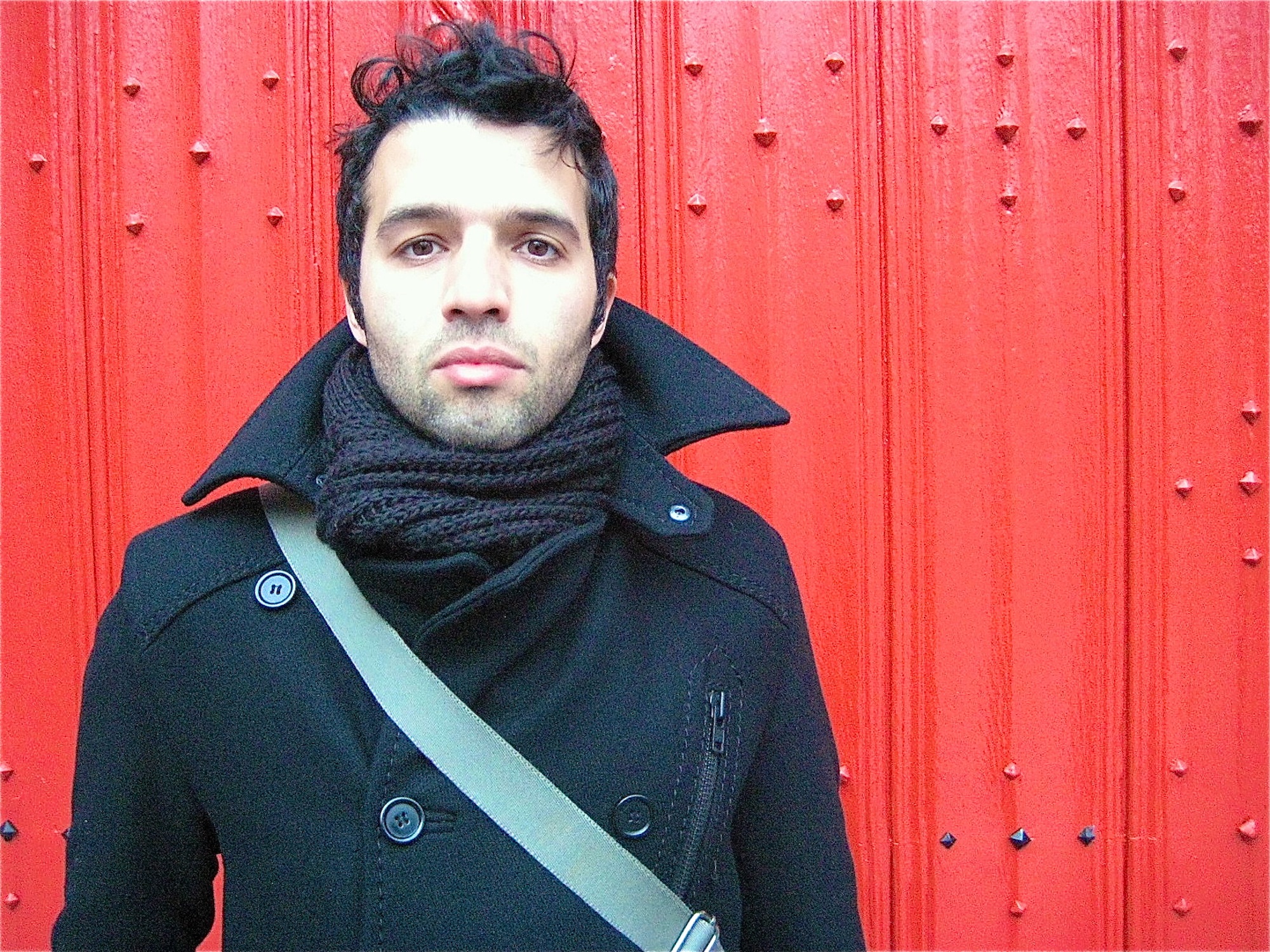
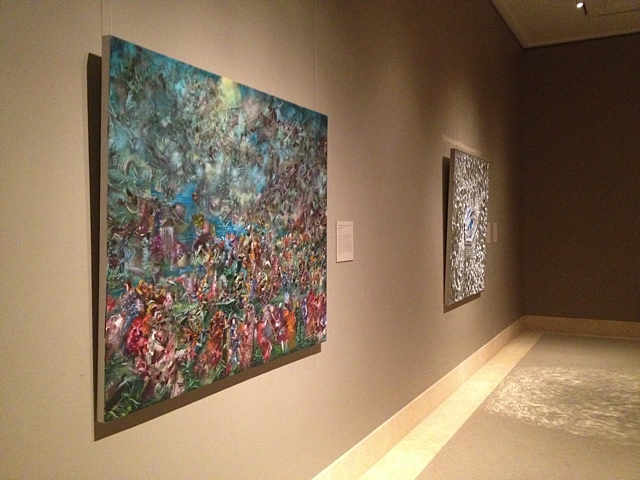
Ali Banisadr, Interrogation, oil on linen, 48 x 60 inches (2010), in "Contemporary Iranian Art from the Permanent Collection" at the Metropolitan Museum of Art
Ranked #1 in Flash Art's Top 100 Artists of 2011, Ali Banisadr is a 36-year-old artist whose painting Interrogation is currently on view at the Metropolitan Museum of Art. Organized by Maryam Ekhtiar, the Met's Associate Curator of Islamic Art, "Contemporary Iranian Art from the Permanent Collection" (March 3 - Sept. 3, 2012) includes art by three generations of artists of Iranian descent and is in the Kevorkian Special Exhibitions gallery nestled among the just-renovated Islamic Wing of the Met. For many visitors, the exhibition is a wonderful surprise, a rare chance to see the discourse between six artists ranging in ages from 88 to 36 years, as well as to see the cultural connections between the new art and the old.
As ambitious as many of the works by the Old Masters in the Met, Banisadr's art addresses universal questions about humankind and life. At the same time, his art is thoroughly post-Modern, eluding easy categorization and incorporating a myriad of artistic influences from both Western and non-Western history along with renowned Modern artists. His artworks entice you to engage in an act of looking that becomes a pleasurable Borges-ian labyrinth where you think you're beginning to figure out what is going on just as you realize you probably do not.
Banisadr's art has an aural quality, a way of experiencing sound through paint and linen. And he has taken the time to learn many of the Old Master techniques in handling oil paint, creating illusions such as light and air, and he fuses those brushwork elements with features of Persian Miniatures, particularly the compositional layering of perspectives and stylization of motifs. He creates his own unique versions of "history paintings"; instead of glorifying the current political systems and power structures, however, his art questions myths, history, what really happened and what is really happening.
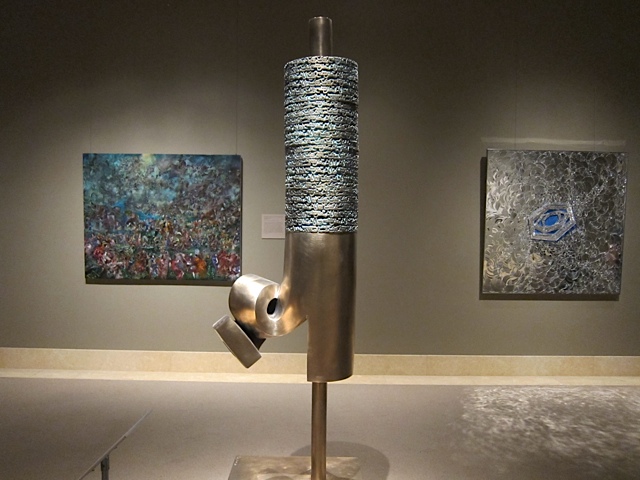
"Contemporary Iranian Art from the Permanent Collection" at the Metropolitan Museum of Art (l-r): Banisadr's Interrogation (2010), Parviz Tanavoli, Poet Turning Into Heech (2007), Monir Shahroudy Farmanfarmaian, Flight of the Dolphin (2010)
JC: I love how Maryam Ekhtiar's terrific exhibition of contemporary Iranian art is right in middle of the Met's New Galleries for the Art of the Arab Lands, Turkey, Iran, Central Asia and Later South Asia.
AB: It is very interesting to walk in the new Islamic Wing and then enter this small exhibition that sort of shows the contemporary artists that are working today in art historical context.
JC: There is a lovely sense of timelessness and movement in many of the works in the contemporary show. Even the sculpture by Parviz Tanavoli is called Poet Turning Into Heech and, even though made of metal, implies transformation. What is striking to you about this show?
AB: You can also look at these works not just in the context of their being Middle Eastern but see they also have a universal appeal to them. I am speaking, for example, of Y. Z. Kami's portrait paintings or Monir's work. Their work doesn't deal just with Iran or the Middle East -- they're entirely relatable and somewhat universal. You don't have to be Middle Eastern to be drawn to these works -- they can speak to the viewer on many levels.
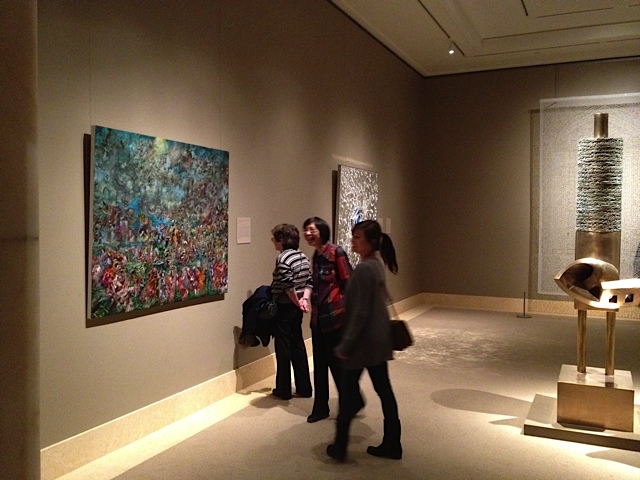
"Contemporary Iranian Art from the Permanent Collection" at the Metropolitan Museum of Art, installation view
JC: Before we discuss Interrogation, your work in this show, I must comment on how photos cannot seem to capture what your paintings really look like in person. And Interrogation is no exception.
AB: Photographing my work has always been a problem not so much for the quality of the reproduction but because the work takes a while for it to unfold it self and show the images within, while a photograph can just give you a glimpse of its abstract surface.
JC: Yes, viewing your paintings is like getting lost in one of Jorges Luis Borges' fictional labyrinths -- I'm in there, looking at one thing then noticing something else, going back, and constantly looking and searching for clues for what is going on. I actually think that how your paintings elude being "captured" in photographs is an apt metaphor for how your art cannot be easily described.
AB: Well, there have been many cases where I had studio visits and, as I was talking about a work, visitors would start to see more and more and discover what the work is really about. It is certainly not a quick read and it needs time.

Ali Banisadr, It Was Written, oil on linen, 16 x 16 inches (2012)
JC: Many have discussed how you're influenced by Bosch, Bruegel, Persian Miniatures, De Kooning, etc. And they talk about your growing up in Tehran during the Iran-Iraq War until the age of twelve and then moving to California and getting involved with graffiti.
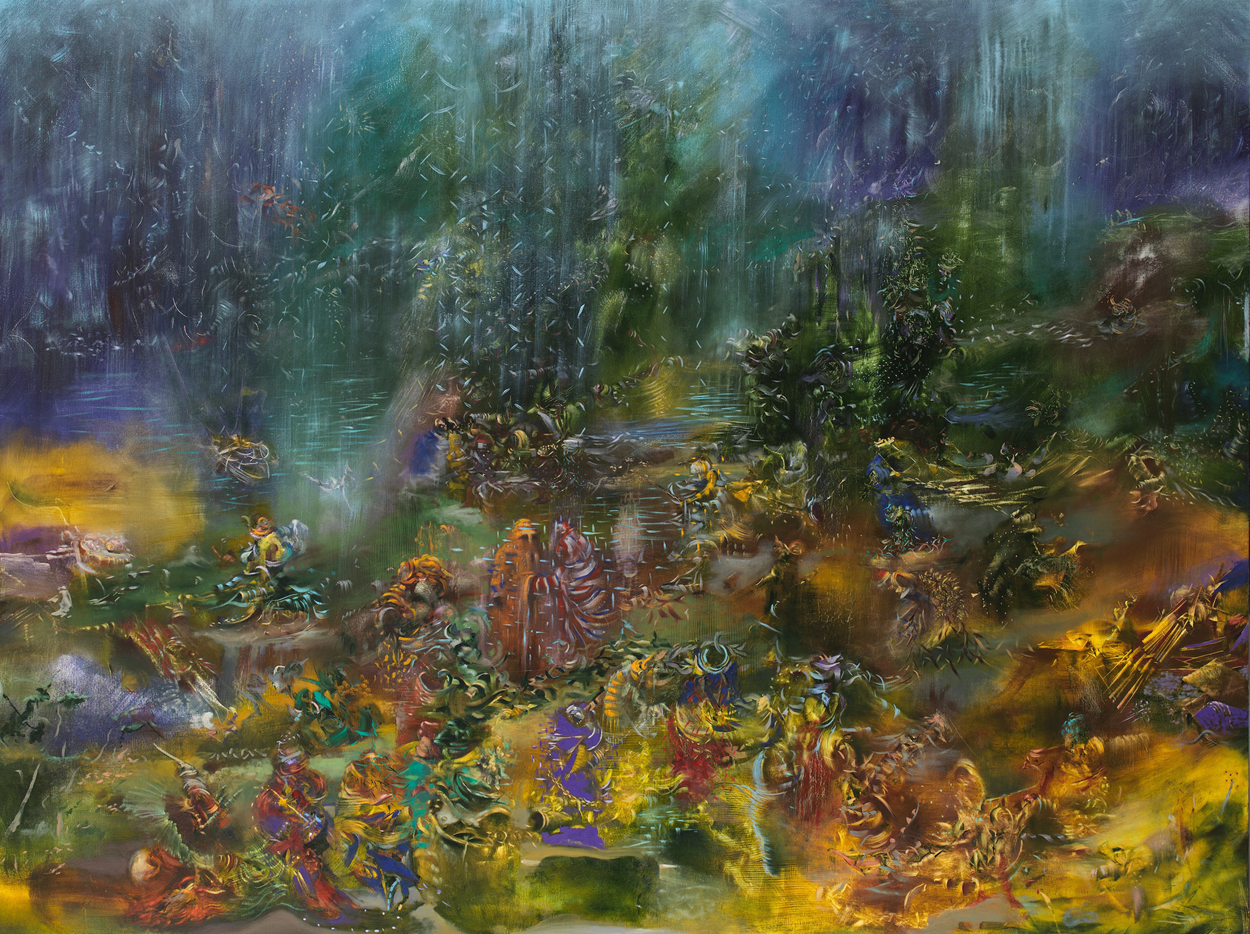
Ali Banisadr, Excavation, oil on linen, 66 x 88 inches (2011)
AB: It is true that there have been so many influences mentioned about my work. All these influences and others are brought into my work subconsciously so perhaps that is why there are glimpses of this and that in my work but there is always so much more than the ones mentioned.
JC: Remember when we were looking at Interrogation together and I said it made me think of Michelangelo's Last Judgment? Your painting doesn't look like The Last Judgment, but it does suggest a similar atmosphere that is chaotic and even apocalyptic. You replied that you have a poster of Michelangelo's masterpiece in your studio and you are around it every day. Is this the subconscious somehow at work here?
AB: Probably. The highlight of my residency in Italy as a student at SVA was visiting The Last Judgment. When I entered the space, I could not move and could not believe what one artist was capable of creating. At the same time I had this feeling of nostalgia as if I had been there before. I found out many years later from my mother that when I was a child she had taken me to the Sistine Chapel to see The Last Judgment. She said I had gone in, was stuck in one place and would not move.
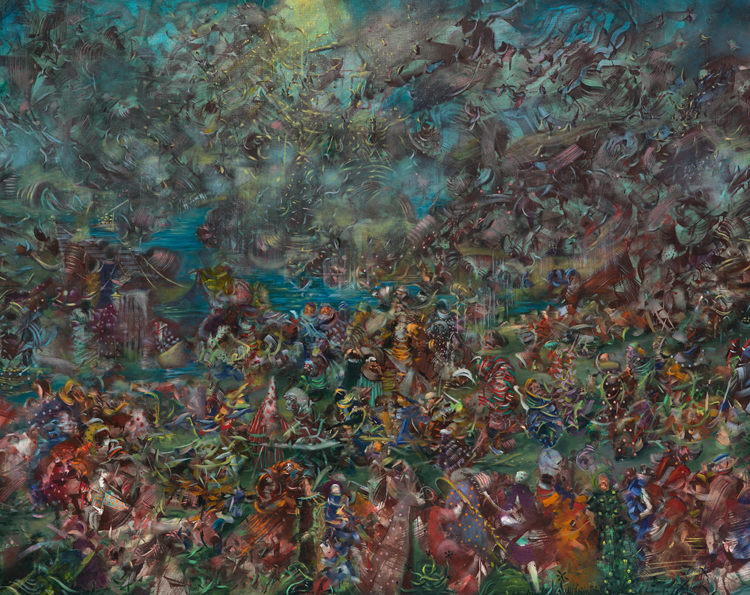
Ali Banisadr, Interrogation, oil on linen, 48 x 60 inches (2010), in the Permanent Collection of the Metropolitan Museum of Art
JC: Like many of your paintings, Interrogation hints at a chaotic field of cacophony and epic action. What is special or important to you about this painting?
AB: With Interrogation, what was really important to me was this sense of light coming from above. I painted a light, which to me, has a symphonic sound to it, and the kind of light that you'd see inside of a church. A lot of paintings have a specific sound to them for me, so this one had its own particular melody that I was trying to bring to the surface.
JC: Yes, 'light that has a sound' -- these are the sorts of things we find when we talk about your work! Your artworks have so much going on in them -- different artistic styles and references, current events, history, personal memory, collective memory, and so on -- and you discuss how your subconscious is involved when you're making your art. MoMA curator Fereshteh Daftari has written brilliantly about your work and she discusses how your titles play a significant role in "decoding" your paintings. But I wonder if your paintings are, in the end, decode-able?
AB: When I am working on a painting, everything that I am thinking about at the time -- be it current events, the books I am reading, personal events, influences, emotions, etc. -- all find their way into my work. And in a way, painting is a way of thinking visually, so whatever is happening with me at the time gets reflected in the work. So the title does at the end give some kind of clue about some of the things I was thinking of when I was making the work.
The work always requires a 50/50 participation with the viewer as they need to complete their half by filling in the spaces that I have left for them to complete.
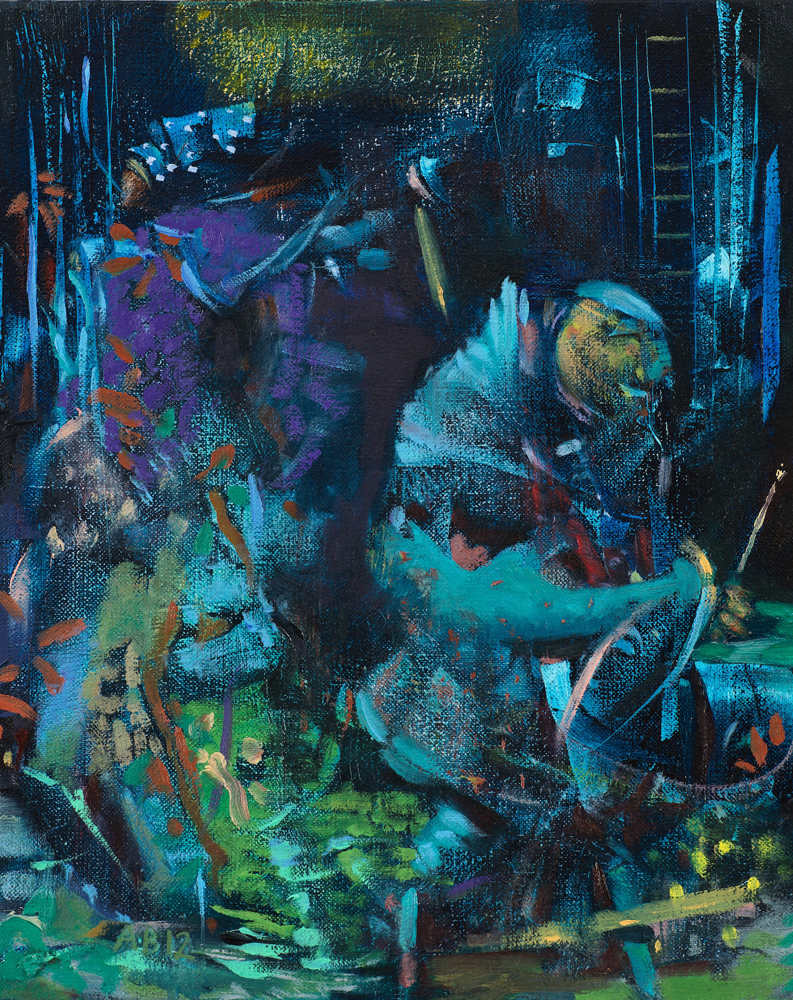
Ali Banisadr, The Myth Makers, oil on linen, 10 x 8 inches (2012)
JC: What about the relationship between your work and that of a non-visual artist like Orhan Pamuk? When you told me his Nobel Prize-winning My Name Is Red is your favorite book, I was struck by some amazing parallels between your works, especially how his multiple narrative structures are literary equivalents of your multiple perspective compositions. By the way, the first line of the book is one of the most amazing beginnings to a work of fiction ever: "I am a corpse."
AB: I read My Name Is Red in 2008 and, just like you, after reading the first line I was hooked. I feel a strong connection with Pamuk's books; he talks about things in his work that echo a lot of my own personal thoughts so that sometimes it is almost scary. Also, his style of his writing is very visual and Miniature-like, and as I went through reading all of his books, I realized there is an echoing of a similar technique in his mixing Old Masters and other literary greats, such as Dostoyevsky, Proust, Tolstoy, Kafka and Borges, and injecting all of that with personal experience, current events and history. This way of writing is like my way of working visually. He is able to weave together so much from so many sources, make it all work and have a poetic rhythm.
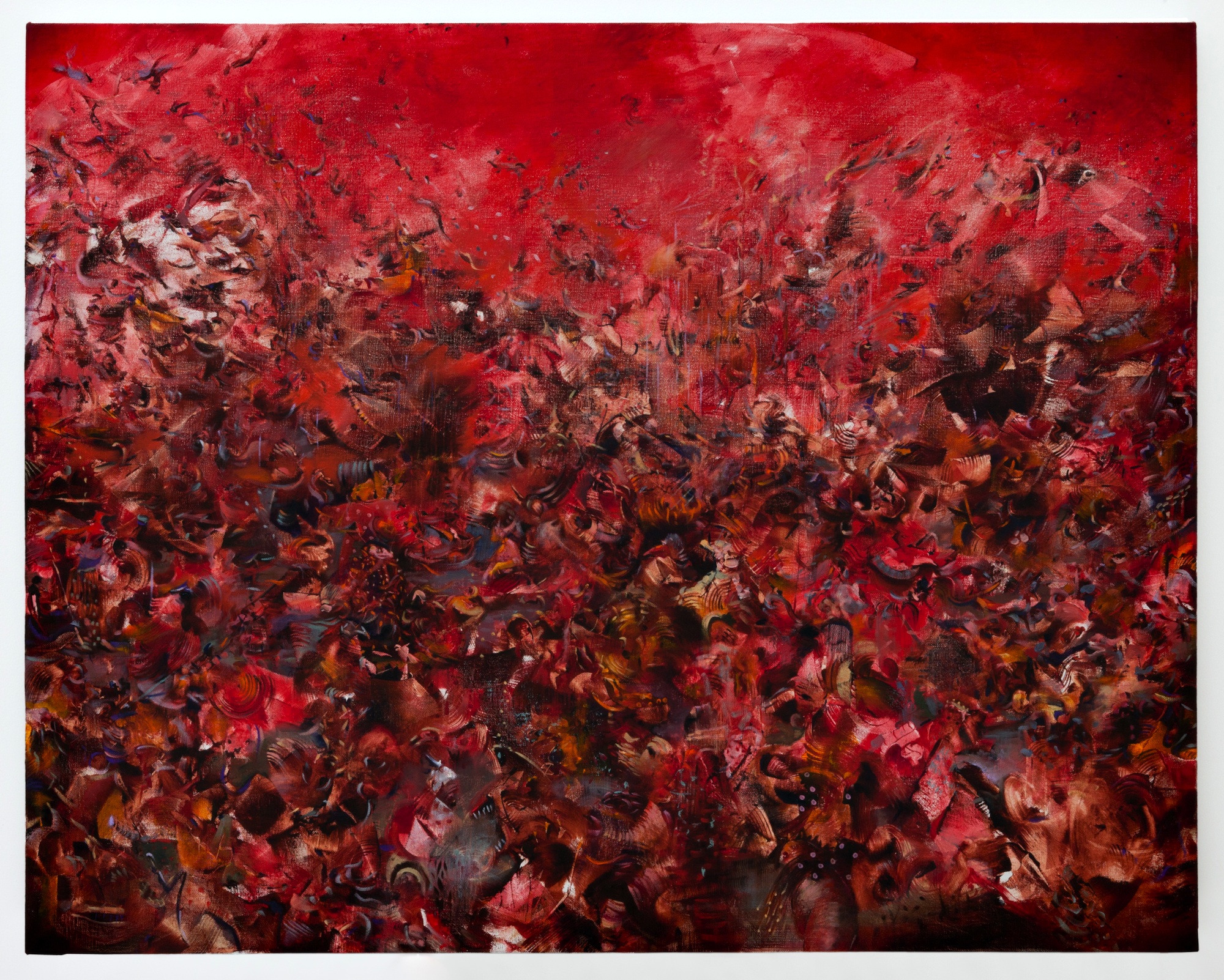
Ali Banisadr, Time for Outrage, oil on linen, 48 x 60 inches (2011)
JC: What is it like having one of your paintings at the Met -- in its permanent collection and on display? When you and I were there, tourists from Sweden wanted to take your picture with your painting and the security guard in the gallery (who also happens to be an artist) shook your hand and congratulated you. You handled it all so graciously.
AB: The Met is my second home, it is just across Central Park from me and I go there often to visit my old master friends and to get advice. It is a place where I can go in and get lost because it is so encyclopedic -- it's like being inside of an Art History book. So to be on display at The Met and in its permanent collection -- it is a true honor for me.
It was interesting to meet the Swedish visitors as I've been to Sweden a few times and was able to practice my little Swedish that I know with them. It was nice to hear their thoughts about my work because they're the general public, the tourists that visit NYC and go to one of the biggest attractions New York has to offer. It's not like when you get the opinion of your friends or family or fellow artists. And the guards at the Met are amazing; I really appreciate what they do.
Photo of Ali Banisadr and his painting Interrogation at the Met taken in August 2012 by Jonatan Blomberg visiting from Sweden with his father; courtesy Jonatan Blomberg
JC: Many might look at your career and think you've had "instant success" because you had your own solo show at a major NYC gallery along with a great New York Times review of it shortly after receiving your MFA and, only a few years later, the Met acquired your work. How would you respond?
AB: I am not sure how others measure success but for me success is about this slow progress in my work which started as a child holding a pencil and paper in my hand. It takes all of what you have learned, experienced and practiced for you to get to where you are, and I have a long way to go because I always have my eye on the big picture.
It has taken me 36 years to get to where I am now and, when you are looking up to artists like Goya, Michelangelo, Velazquez and Bosch, for example, you realize that you have a long way to go and may never even reach close to what these artists reached in their time. Painting is a slow process; it takes time to get there, you learn little by little and always want the next painting to be better than the last. For me, success is about this, seeing the slow progress in my work.
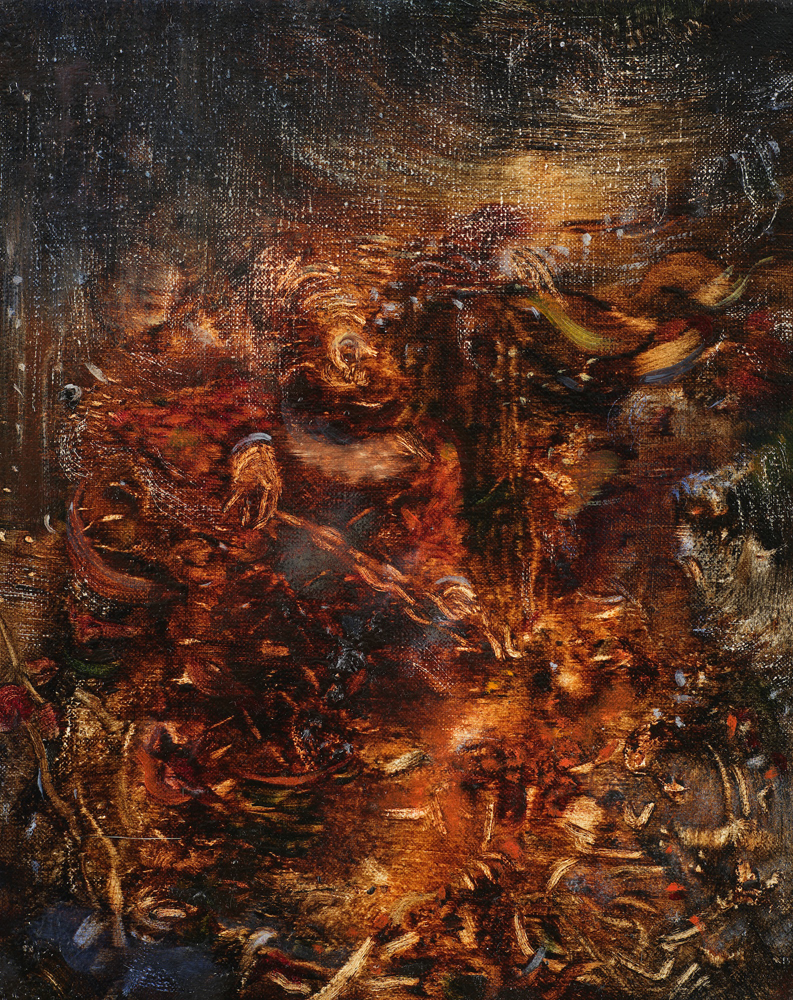
Ali Banisadr, History, oil on linen, 10 x 8 inches (2012)
Ali Banisadr
All images courtesy of the artist.
Note: A longer version of this interview with more images is available at juliechaeprojects.com under the Writings tab.
More information is available at: http://www.ali-banisadr.com/ and
http://www.metmuseum.org/exhibitions/listings/2012/contemporary-iranian-art
